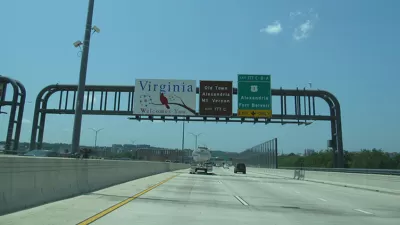State transportation leaders are scrambling to increase funding as MAP-21 draws to its expiration on Oct. 1. Interstate tolling is being eyed by more than a few. While the Wisconsin Assembly likes the idea, Gov. Scott Walker rejects it.
"The gas tax is not bringing in enough money to meet its needs, the steady stream of federal transportation money may be in jeopardy and voters do not want to pay more taxes," writes Daniel C. Vock about the transportation funding crisis in what could be almost any state in the U.S. in light of a 20-year drought in raising federal gas taxes. In this case, he writes about the Badger State, just as he did in 2011 with Arizona, and Rhode Island.
The crisis was laid out last year in a 176-page report [Jan. 2013, PDF] to Wisconsin lawmakers on the funding problems and the deteriorating road network. Legislators received another reminder in September, when Green Bay officials had to close [the Leo Frigo] bridge [on Interstate 43] that carries 40,000 vehicles a day because it was sagging [see video]. It took until January to fix and reopen the bridge.
As we have noted, tolls are one solution that states have looked toward as alternatives to raising state gas taxes and implementing new vehicle-miles-traveled fees (only Oregon has an actual VMT fee). In this piece, the focus is on getting Congress to explicitly allow the tolling of Interstate highway in the new transportation reauthorization bill to be written this spring and summer
In their scramble to find new funds, leaders in Wisconsin and other states are eyeing the same solution: tolls on highways. Federal law bans most states from tolling existing interstates, but officials in Wisconsin and in other states hope Congress will change that law this year, when it writes a new surface transportation bill to replace one that expires Oct. 1.
“All we're asking for is giving the states the flexibility, if they want to take on that challenge, to see if they can sell it,” said Jim Tymon, director of program finance and management for the American Association of State Highway and Transportation Officials.
While others, such as the Reason Foundation and the International Bridge, Tunnel and Turnpike Association, a group that represents toll operators and vendors, support that position, many other powerful players don't, most notably the American Trucking Associations (see their Alliance for Toll-Free Interstates) who have come out as staunch supporters for increasing transportation fuel taxes.
“Tolling existing interstate lanes is the least efficient, least effective mechanism to fund transportation in the long term,” said Hayes Framme, a spokesman for the Alliance for Toll-Free Interstates, whose members also inclue UPS, FedEx, McDonald’s, Dunkin’ Donuts and other groups.
Others would disagree as we noted in November. “There’s a fairness argument,” added Leonard Gilroy, director of government relations at the Reason Foundation, a libertarian think tank in Los Angeles. “If you use the roadway, you pay. If you don’t, you don’t.” [See "How Interstate Tolling Could Work"].
Vock provides a concise history of interstate tolling, from the inception of the 1956 Interstate Highway Act, to the interstate tolling pilot program in 1998 that allowed three states to impose new tolls: Missouri, North Carolina and Virginia, though they have yet to do so..
"The idea (of being allowed to toll the interestates)vdid produce some bipartisan agreement in the Wisconsin State Assembly, a chamber that has experienced deep party divides in recent years," writes Vock.
Peter Barca, the chamber’s Democratic leader, said tolls would be the “best approach” to pay for transportation.
Not on board is Gov. Scott Walker, a Republican facing re-election this fall and possible presidential candidate, who prefers to build new High Occupancy Toll lanes, capital intensive projects that have been shown to not necessarily be popular with road users as we noted recently.
However, new HOT lanes on interstates "would be permissible under current federal law, because it would add road capacity instead of adding tolls to existing lanes."
FULL STORY: As Highway Money Runs Dry, Congress Considers Lifting Toll Ban

Planetizen Federal Action Tracker
A weekly monitor of how Trump’s orders and actions are impacting planners and planning in America.

Chicago’s Ghost Rails
Just beneath the surface of the modern city lie the remnants of its expansive early 20th-century streetcar system.

San Antonio and Austin are Fusing Into one Massive Megaregion
The region spanning the two central Texas cities is growing fast, posing challenges for local infrastructure and water supplies.

Since Zion's Shuttles Went Electric “The Smog is Gone”
Visitors to Zion National Park can enjoy the canyon via the nation’s first fully electric park shuttle system.

Trump Distributing DOT Safety Funds at 1/10 Rate of Biden
Funds for Safe Streets and other transportation safety and equity programs are being held up by administrative reviews and conflicts with the Trump administration’s priorities.

German Cities Subsidize Taxis for Women Amid Wave of Violence
Free or low-cost taxi rides can help women navigate cities more safely, but critics say the programs don't address the root causes of violence against women.
Urban Design for Planners 1: Software Tools
This six-course series explores essential urban design concepts using open source software and equips planners with the tools they need to participate fully in the urban design process.
Planning for Universal Design
Learn the tools for implementing Universal Design in planning regulations.
planning NEXT
Appalachian Highlands Housing Partners
Mpact (founded as Rail~Volution)
City of Camden Redevelopment Agency
City of Astoria
City of Portland
City of Laramie



























